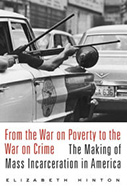FROM THE WAR ON POVERTY TO THE WAR ON CRIME: THE MAKING OF MASS INCARCERATION IN AMERICA

Author: Elizabeth Hinton
Publisher: Cambridge, MA; London: Harvard University Press, 2016. 464p.
Reviewer: Hadar Aviram | January 2017
It is tempting and, to a degree, justifiable, to credit the Nixon campaign and presidency with the explosion of American mass incarceration. Nixon’s campaign put crime on the national agenda, resulting in forty decades of political posturing and governing through crime. However, in recent years, several accounts of mass incarceration—notably by Marie Gottschalk and Naomi Murakawa—have revised this received wisdom, highlighting the role of liberals and progressives in bringing about the incarceration crisis.
Elizabeth Hinton’s new From the War on Poverty to the War on Crime is a contribution along the same lines. Like Gottschalk and Murakawa, Hinton sees Nixon’s incarceration politics less as a break from what preceded them and more as a continuation of a trend. Hinton’s account, however, differs in that she offers a detailed ground level analysis of national crime policy trends, including a thorough political and financial analysis of their contribution to the rise in crime control and in incarceration. Hinton’s main argument is that Lyndon Johnson’s declared War on Poverty was far from being the opposite of the War on Crime. Rather, both campaigns shared important assumptions about crime and delinquency, primarily around race. Not only was the War on Crime a natural continuation of the War on Poverty along these lines, but the War on Poverty itself wove together a racialized program of social betterment and a racialized program of supervision and surveillance, which set the stage for later developments.
Hinton’s analysis of national policy during the Kennedy and Johnson presidencies is masterful and valuable. Providing a realistic timeline of reforms, policies, and measures, she makes a convincing case that concerns about juvenile delinquency by inner-city youths of color were already present in the Kennedy days. Moreover, this concern intensified during the Johnson presidency, and fueled both the neighborhood improvement projects and the early beginnings of surveillance of youth of color who were perceived as hardened and potential career criminals. It is particularly interesting that Hinton focuses on the role played by Cloward and Ohlin, authors of the influential Differential Opportunities Theory, on the formation of these strategies. With Ohlin at the planning helm, neighborhood interventions by benign reformers targeted what was perceived as the pathological single parent black family, introducing external mentors to indoctrinate teenagers in appropriate exploits and vocational opportunities. At the same time, neighborhood youth coming from said pathological families were being followed and supervised, using surveillance projects that were perceived as disconcerting and constitutionally problematic but also effective.
Not quick to let Johnson off the hook by comparison to his presidential successor, Hinton reminds us of the bland makeup of his Commission on Law Enforcement and Administration of Justice, as well as for his parting shot, the Omnibus Crime Control and Safe Streets Act of 1968. Her account of the signing of the Act is more complex and offers more shades of gray than the traditional accounts, which villainize Nixon for his 1970 expansion of the Act.
But Hinton’s account does not acquit Nixon of responsibility for the exponential growth of the criminal justice apparatus. She provides a deep analysis of the Law Enforcement Assistance Administration (LEAA), and especially of its financial implications for urban police department. Several scholars have commented on the effect of LEAA on urban policing, and by extension, on the criminal justice system, but never before has a careful analysis of the funding been conducted. Hinton shows how the focus on improving the capabilities of municipal police departments was designed to target street crime by African American youth.
What follows is a careful analysis of the crackdown on juvenile crime as an epidemic. It is of particular value today, as we wake up to a rediscovery of childhood, to read Hinton’s account of how our concept of childhood disappeared in the first place, especially in the context of inner city black youth.
Another important contribution of the book is its placement of the war on drugs. Hinton discusses the Reagan administration’s focus on drugs as a later development, powerfully countering the narrative that the racially discriminatory effect of the correctional system has always stemmed from drug enforcement. She mentions the concerns of prior administrations with drugs, but shows that the focus on urban crime by racial minorities was not particularly focused on drugs until the powerful shift during the early 1980s.
The difficulty in providing critical historical accounts of criminological intervention is in assessing their benevolence. I share Hinton’s apprehension about the racialized assumptions made by progressives of the time (her observations dovetail with those recently made by Khalil Gibran Muhammad, though his account also focuses on earlier historical periods). However, I think that her harshness toward Ohlin and his contemporaries is a bit unwarranted given the context in which they wrote and worked. Cloward and Ohlin developed their theory under the influence of Merton’s Strain Theory, the first effort in mainstream American criminology to account for the effect of stratification and inequality in crime. It’s easy to see the warts in these theories now, when we are informed by critical and radical criminology, but for their time they were revolutionary and important. While, as Hinton explains, much of the crime picture on which they based their suggestions for intervention was inaccurate and filtered through racist perspectives, not all of their initiatives are deserving of the critique they receive in the book. Perhaps, in an effort to correct the perception that crime politics are partisan, the book goes a bit too far in criticizing reformers who, as Hinton herself carefully notes, had “the best intentions.”
But this is a minor quibble with an overall important and informative manuscript, which provides a probing view into the less investigated aspects of the birth of mass incarceration, getting at its very root, and offering all of us, regardless of our political orientation, a valuable and important mirror for uncomfortable and essential self-reflection.
Hadar Aviram, Professor of Law, Harry and Lillian Hastings Research Chair, University of California, Hastings College of the Law, Author, Cheap on Crime: Recession-Era Politics and the Transformation of American Punishment


